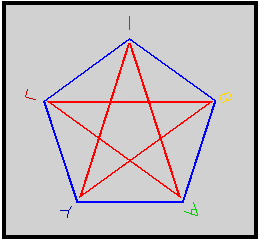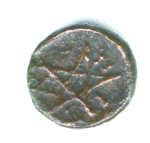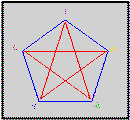
The Pythagorean Pentacleby Apollonios Sophistes
|

The Pythagorean Pentacleby Apollonios Sophistes
|
 Pentagram on
reverse of a small bronze coin (AE10) from Pitane, Mysia, 4th-3rd
cent. BCE. Letters around the pentagram spell
Pentagram on
reverse of a small bronze coin (AE10) from Pitane, Mysia, 4th-3rd
cent. BCE. Letters around the pentagram spell  (PITAN).
(PITAN).
The pentagram and hexagram were both used for protection in ancient Greece (V cent. BCE). In Babylon, five-, six- and seven-rayed stars were all used. The pentagram appears in the earliest writing of Mesopotamia (precuneiform pictographic writing), c. 3000 BCE, as the Sumerian sign UB. Its meaning in the cuneiform period (by 2600 BCE) seems to be a Heavenly Quarter and also the four directions (forward, backward, left, right); the fifth direction was "above." The four directions corresponded to the planets Jupiter, Mercury, Mars and Saturn, with Venus the Queen of Heaven (Schekina) above. These are the "Smaller Planets" (omitting Sun and Moon). Ishtar (Venus) was represented by the Eight-rayed Star (Elam). See De Vogel (App. A) and Black & Green (s.v. Star).
Pythagoras may have become acquainted with the Pentagram during
his sojourns in Egypt and Babylon (perhaps 554-533 BCE); in any
case the Pythagoreans used it as a sign of recognition (Iambl., Vita
Pyth. XXXIII). They called the Pentagram  (Hugieia), which is usually
translated "Health," but has more the sense of Soundness or
Wholeness, and, more generally, any Divine Blessing (LSJ s.v.
hugieia, Suppl. s.v. hugieia). (Hugieia comes from the same
Indo-European root as gives us "quick" [i.e. living], "viva,"
"vital," "bios" [life], "zôê" [life] and "azoth." It has been
traditionally associated with "vigor", "vigil" and the Latin words
"vegetus" [lively, vigorous] and "vegeo" [to quicken], which come
from the same Indo-European root as "Wicca" and "Witch.") The
Pentagram was still used to mean "Hugieia" in Paracelsus' time
(c.1493-1541). The Pythagoreans also used "Be sound / whole /
blessed!" (
(Hugieia), which is usually
translated "Health," but has more the sense of Soundness or
Wholeness, and, more generally, any Divine Blessing (LSJ s.v.
hugieia, Suppl. s.v. hugieia). (Hugieia comes from the same
Indo-European root as gives us "quick" [i.e. living], "viva,"
"vital," "bios" [life], "zôê" [life] and "azoth." It has been
traditionally associated with "vigor", "vigil" and the Latin words
"vegetus" [lively, vigorous] and "vegeo" [to quicken], which come
from the same Indo-European root as "Wicca" and "Witch.") The
Pentagram was still used to mean "Hugieia" in Paracelsus' time
(c.1493-1541). The Pythagoreans also used "Be sound / whole /
blessed!" ( , Hugiaine!) as
their greeting or password (Scholia in Aristoph., Nubes
609; Lucian, Pro lapsu 5). In fact Bonner (p. 177) notes
that "Hugieia" is a fairly common inscription on amulets, and that
Perdrizet thinks it and similar inscriptions are Oriental in
origin (although the word is Greek). Hugieia (Hygeia) is also, of
course, the Goddess of Health, called Salus by the Romans; She is
the daughter of the God Aesculapius.
, Hugiaine!) as
their greeting or password (Scholia in Aristoph., Nubes
609; Lucian, Pro lapsu 5). In fact Bonner (p. 177) notes
that "Hugieia" is a fairly common inscription on amulets, and that
Perdrizet thinks it and similar inscriptions are Oriental in
origin (although the word is Greek). Hugieia (Hygeia) is also, of
course, the Goddess of Health, called Salus by the Romans; She is
the daughter of the God Aesculapius.
 (U-G-I-EI-A). The fact that
(U-G-I-EI-A). The fact that  (UGIEIA) has six letters is an
inconvenience, and Allman observes that the Pythagoreans wrote
upsilon, gamma, iota, theta, alpha at the points, perhaps because an
adjacent epsilon and iota (
(UGIEIA) has six letters is an
inconvenience, and Allman observes that the Pythagoreans wrote
upsilon, gamma, iota, theta, alpha at the points, perhaps because an
adjacent epsilon and iota ( ) look something like a theta (
) look something like a theta ( ). Chasles (1875, p.
478-479) likewise lists these five letters, quoting Alstedius
(Encyc. univ., 1620) and Kircher (Arithmologia, 1665).
). Chasles (1875, p.
478-479) likewise lists these five letters, quoting Alstedius
(Encyc. univ., 1620) and Kircher (Arithmologia, 1665).
Looking at the figure in Agrippa's De occulta philosophia
(Lib. III, cap. xxi) we see an upright pentagram surrounded by two
rings; between the rings and aligned with the angles between the
pentagram's points are Greek letters reading clockwise:  (UGI?A). The mysterious fourth
letter is not entirely clear in my edition of Agrippa (Brill,
1992), but its appearance is consistent with a common medieval
abbreviation for EI or ei (which looks vaguely like a
theta, but more like a dollar sign made without lifting the pen).
(UGI?A). The mysterious fourth
letter is not entirely clear in my edition of Agrippa (Brill,
1992), but its appearance is consistent with a common medieval
abbreviation for EI or ei (which looks vaguely like a
theta, but more like a dollar sign made without lifting the pen).
Vincenzo Cartari's Le Imagini degli Dei degli Antichi
(Venezia 1609, Padova 1626) shows a Pythagorean signet ring
bearing an upright pentagram labeled with both Hugieia
and Salus. The Greek letters  (UGEIA) are clockwise in the points, beginning with the upper-left
arm. The Roman letters SALUS are clockwise in the angles,
beginning with the lower-left angle (Latin Salus has the
same meaning as Hugieia).
(UGEIA) are clockwise in the points, beginning with the upper-left
arm. The Roman letters SALUS are clockwise in the angles,
beginning with the lower-left angle (Latin Salus has the
same meaning as Hugieia).
So, although we can conclude that the Pythagoreans labeled the
Pentagram with the letters  (U-G-I-EI-A), sometimes we find them clockwise, sometimes
counterclockwise, and either placed on the points starting at the
top (Alstedius, Kircher), or in the angles starting at the top
right (Agrippa). Since the historical evidence for the placement
is late and inconsistent, I have developed a Pythagorean Pentacle
that embodies many important alchemical, magical and astrological
relationships; indeed, it functions as a sort of alchemical
computer. The pentagram is inscribed in a pentagon with the
letters U, G, I, EI (or Th), A written clockwise on the points
beginning in the lower left point:
(U-G-I-EI-A), sometimes we find them clockwise, sometimes
counterclockwise, and either placed on the points starting at the
top (Alstedius, Kircher), or in the angles starting at the top
right (Agrippa). Since the historical evidence for the placement
is late and inconsistent, I have developed a Pythagorean Pentacle
that embodies many important alchemical, magical and astrological
relationships; indeed, it functions as a sort of alchemical
computer. The pentagram is inscribed in a pentagon with the
letters U, G, I, EI (or Th), A written clockwise on the points
beginning in the lower left point:
 (U) (U) |
 (Hudor) (Hudor) |
Water | |||
 (G) (G) |
 (Gaia) (Gaia) |
Earth | |||
 (I) (I) |
 (Idea) (Idea) |
Form/Idea, or | |
 (Hieron) (Hieron) |
a divine, holy thing |
 (EI) (EI) |
 (Heile) (Heile) |
Sun's Warmth or |  (Th) (Th) |
 (Therma) (Therma) |
Heat |
 (A) (A) |
 (Aer) (Aer) |
Air |
 (UG/I/EIA) or
(UG/I/EIA) or  UG/I/ThA), matches the arch
structure of the Pentacle; interestingly the Greek word Hugieia (
UG/I/ThA), matches the arch
structure of the Pentacle; interestingly the Greek word Hugieia ( ) has a high-tone (acute) accent on
the Iota (corresponding to Spirit), which seems appropriate.
) has a high-tone (acute) accent on
the Iota (corresponding to Spirit), which seems appropriate.
This seems to be the only arrangement of the
Elements on the Pentagram that generates ΥΓΙΕΙΑ (UGIEIA) or  (UGIThA) - let alone both - from
plausible Element names. Also I should note that the above
Element names are the usual ones that appear, for example, in
Aristotle, except Fire, where Pur is used; however
Empedocles (who discovered the Four Elements) uses Eelios
= Sun, which is described as Thermos, for Fire (DK 31B
21; see also Kirk, Raven & Schofield 292-3). Also, although
Aristotle uses Aither for the Fifth Element
(Quintessence), Plato clearly associates it with the World of
Forms (Ideai). I think Hieron (a holy, divine
thing) is also appropriate for the Quintessence (which resides
in the Celestial Sphere).
(UGIThA) - let alone both - from
plausible Element names. Also I should note that the above
Element names are the usual ones that appear, for example, in
Aristotle, except Fire, where Pur is used; however
Empedocles (who discovered the Four Elements) uses Eelios
= Sun, which is described as Thermos, for Fire (DK 31B
21; see also Kirk, Raven & Schofield 292-3). Also, although
Aristotle uses Aither for the Fifth Element
(Quintessence), Plato clearly associates it with the World of
Forms (Ideai). I think Hieron (a holy, divine
thing) is also appropriate for the Quintessence (which resides
in the Celestial Sphere).
 To see
what's going on more clearly, you might want to draw a Pentagram
with a circumscribed Pentagon. It will be helpful later if you
draw the Pentagram and Pentagon in contrasting colors. The lower
trapezoid of the figure is then a (distorted) Square of
Opposition representing the Four Mundane Elements
Earth-Water-Air-Fire. Spirit stands above these, forming a
pyramid over them.
To see
what's going on more clearly, you might want to draw a Pentagram
with a circumscribed Pentagon. It will be helpful later if you
draw the Pentagram and Pentagon in contrasting colors. The lower
trapezoid of the figure is then a (distorted) Square of
Opposition representing the Four Mundane Elements
Earth-Water-Air-Fire. Spirit stands above these, forming a
pyramid over them.
First observe that the Pentacle embodies the Physical Order of the Elements; if we stay on the Mundane level we have Earth-Water-Air-Fire, and we can make it a cycle counterclockwise (as in the Alchemical Circulation) by returning from Fire to Earth across the horizontal beam of the Pentagram. Likewise, the Pentacle includes the Extended Physical Order (the Metaphysical Order), which includes the ascent to Spirit: Earth-Water-Air-Fire-Spirit by a counterclockwise circuit. Of course we get the descent Spirit-Fire-Air-Water-Earth by going clockwise.
| Quality | Age | Season | Moon |
|---|---|---|---|
| Wet | Child | Spring | 1st Q. |
| Hot | Youth | Summer | 2nd Q. |
| Dry | Maturity | Autumn | 3rd Q. |
| Cold | Old Age | Winter | 4th Q. |
Since the Qualities are shared by pairs of elements, they actually fall on the lines of the Pythagorean Pentacle. For example, Wet corresponds to the line connecting Water (U) and Air (A). If we look at the Pentacle as a Pyramid, the four lines around the base represent the Four Powers in their mundane manifestation. The four sides rising above them toward the apex (corresponding to Spirit) represent the elevation or aetherialization of the Powers (at the apex they all become identical; this is the alchemical Quintessence; see "The Rotation of the Elements," Caduceus, Vol. 1, No. 4).
Although the Powers properly belong on the lines between the points, it is often convenient to place them on the points, thus identifying them with the Elements. Aristotle showed that one of the two Powers constituting an Element is dominant (the first of the two given in the equations above), so Earth is predominantly Dry, Water is Cold, Air is Wet and Fire is Hot. These correspondences may not be entirely obvious (and other philosophers, such as the Stoics, have done them differently), but overall they work best, especially for alchemy. When we apply them we get the following correspondences for the points of the Pentagram:
| Letter | Element | Power | Age | Season | Moon |
|---|---|---|---|---|---|
| A | Air | Wet | Child | Spring | 1st Q. |
| EI | Fire | Hot | Youth | Summer | 2nd Q. |
| G | Earth | Dry | Maturity | Autumn | 3rd Q. |
| U | Water | Cold | Old Age | Winter | 4th Q. |
| |
|||||
| I | Spirit | Divine | Death | Terror Time | New Moon |
The first four numbers also represent processes of growth or development. For example,
| Num. | Elem. | Lifestage | Season |
|---|---|---|---|
| 1 | Fire | Child | Spring |
| 2 | Air | Youth | Summer |
| 3 | Water | Maturity | Autumn |
| 4 | Earth | Old Age | Winter |
| |
|||
| 5/0 | Spirit | Death | Terror Time |
| 1 |  (EI) (EI) |
Fire | five strokes |
| 2 |  (A) (A) |
Air | four strokes (with broken crossbar)* |
| 3 |  (U) (U) |
Water | three strokes |
| 4 |  (G) (G) |
Earth | two strokes |
| 5 |  (I) (I) |
Spirit | one stroke |
In Babylonian astrological tablets dating back to at least the fourth century BCE, the Minor Planets are assigned to Signs of the Zodiac in the order Jupiter, Venus, Saturn, Mars, Jupiter, etc. (Rochberg-Halton). That is, they are assigned according to the descending cycle of elements: Fire, Air, Water, Earth. Therefore, Jupiter is Lord of the Aries-Leo-Sagittarius triplicity, Venus of Taurus-Virgo-Capricorn, Saturn of Gemini-Libra-Aquarius and Mars of Cancer-Scorpio-Pisces. The Fixed Signs of these triplicities correspond to the Seasons, as already enumerated: Air-Taurus-Spring-Wet, Fire-Leo-Summer-Hot, Earth-Scorpio-Autumn-Dry, Water-Aquarius-Winter-Cold. (These are not the elemental association now current in astrology, which apparently derive from Vetius Valens' Anthologia, although they are consistent with Ptolemy's Tetrabiblos; both date from the 2nd. cent. CE.)
The Greater Lamps, the Sun and Moon, do not have a place on the Pentagram, but stand above it, the Moon on the left and the Sun on the right. They govern the two Shamanic Paths: The Left-hand Path is the Way of the Moon, which descends to the Underworld by means of the element Earth and the Water below it (i.e. the Abyss). The Right-hand Path is the Way of the Sun, which ascends to the Heavens by means of the elements Air and the Fire above it (the Celestial Fire). Both Paths are valid and appropriate according to circumstances. (See Opsopaus' "Olympic Lesser Banishing Ritual," Caduceus vol. 1, no. 1, and references therein for more on the two Paths.)
The Four Powers are associated naturally with Jung's Four Functions: Feeling (Wet) opposite Thinking (Dry), Intuition (Hot) opposite Sensation (Cold); the Transcendent Self (Spirit) stands above them all. The Wet/Dry functions are "evaluative," the Hot/Cold are "experiential." Four Gods correspond to the Four Functions: Venus (Feeling, love), Minerva (Thinking, wisdom), Jupiter (Intuition, the "bolt from the blue"), Neptune (Sensation, lord of the earth/physical reality). Thus we have:
| Element | Deities | Function | Power | Planet |
|---|---|---|---|---|
| Spirit | Mercury | Self | Divine | Mercury |
| Fire | Jupiter | Intuition | Hot | Jupiter |
| Air | Hera, Aphrodite | Feeling | Wet | Venus |
| Water | Neptune | Sensation | Cold | Saturn |
| Earth | Ceres, Minerva | Thinking | Dry | Mars |
Tip: If you work in Wiccan or Golden Dawn traditions, with their directional associations (East-Air, South-Fire, West-Water, North-Earth), but don't want to get the alchemical structure of the elements garbled, then use the Ptolemaic assignments. Instead of Air, think Dry East Wind; instead of Fire, Hot South Wind; instead of Water, Wet West Wind; instead of Earth, Cold North Wind. That is, you will be working in terms of the Powers, which have the correct oppositional structure, rather than the Elements, which don't.
 This
brings us to an interesting property of the Pythagorean Pentacle
(the Pentagram with circumscribed Pentagon). In mathematical
terminology the Pentagram is dual to the Pentagon (one is like the
other turned inside-out). To see this draw a black Pentagram in a
red Pentagon, and a red Pentagram in a black Pentagon; each
Pentacle is the dual of the other. For example, if we number the
first Pentagon clockwise around its corners, and next trace the
lines of its Pentagram and transfer the numbers counterclockwise
to the corners of the second Pentagon, then our Pentacles will be
labeled:
This
brings us to an interesting property of the Pythagorean Pentacle
(the Pentagram with circumscribed Pentagon). In mathematical
terminology the Pentagram is dual to the Pentagon (one is like the
other turned inside-out). To see this draw a black Pentagram in a
red Pentagon, and a red Pentagram in a black Pentagon; each
Pentacle is the dual of the other. For example, if we number the
first Pentagon clockwise around its corners, and next trace the
lines of its Pentagram and transfer the numbers counterclockwise
to the corners of the second Pentagon, then our Pentacles will be
labeled: Now label the Pythagorean Pentacle with the Elements as described above; I will call this the Elemental Pentacle. Next trace the lines of the Elemental Pentagram in Counterclockwise Order (Spirit, Water, Fire, Earth, Air) and lay out these elements in Clockwise Order around the corners of the second Pentagon; they will be arranged as follows:
As is well known, Plato associates the Five Elements with the Five Platonic Solids (Tim. 55c-65c), and Kepler made a similar association between the Planets and the Platonic Solids. So let's lay out the Platonic Solids around the Golden Dawn Pentacle; I'll abbreviate the Solids by their number of faces:
| 4 | Tetrahedron | Fire |
| 6 | Cube | Earth |
| 8 | Octahedron | Air |
| 12 | Dodecahedron | Spirit |
| 20 | Icosahedron | Water |
So the Golden Dawn Pentacle also has some interesting Correspondences, though it loses the Directional and Organic Cycles and especially the Square of Opposition, which I think is fundamental and essential. Needless to say, they can be profound Mandalas for meditation if fully labeled with color-coded Correspondences.
 Send
comments about this page
Send
comments about this page